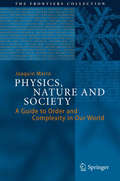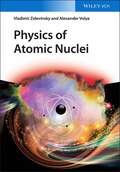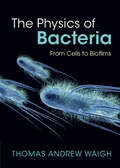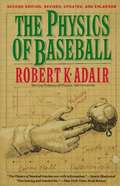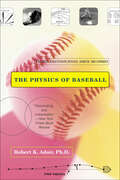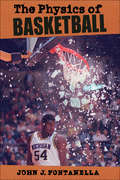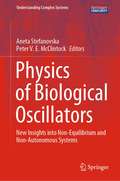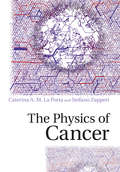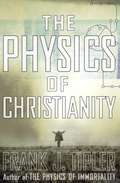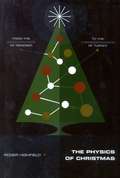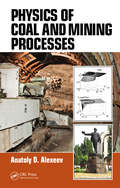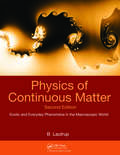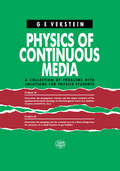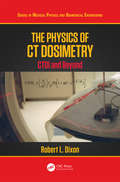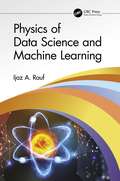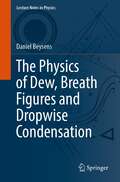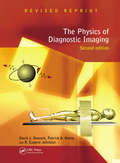- Table View
- List View
Physics Made Simple
by Christopher Gordon De PreeUnderstand the rules that make the universe run. Understanding the laws of physics is essential for all scientific studies, but many students are intimidated by their complexities. This completely revised and updated book makes it easy to understand the most important principles. From the physics of the everyday world to the theory of relativity, PHYSICS MADE SIMPLE covers it all. Each chapter is introduced by anecdotes that directly apply the concepts to contemporary life and ends with practice problems--with complete solutions--to reinforce the concepts. Humorous illustrations and stories complete the text, making it not only easy but fun to learn this important science. Topics covered include: *force *motion *energy *waves *electricity and magnetism *the atom *quantum physics *relativity *spectroscopy *particle physics.
Physics, Nature and Society
by Joaquín MarroThis wide-ranging and accessible book serves as a fascinating guide to the strategies and concepts that help us understand the boundaries between physics, on the one hand, and sociology, economics, and biology on the other. From cooperation and criticality to flock dynamics and fractals, the author addresses many of the topics belonging to the broad theme of complexity. He chooses excellent examples (requiring no prior mathematical knowledge) to illuminate these ideas and their implications. The lively style and clear description of the relevant models will appeal both to novices and those with an existing knowledge of the field.
Physics, Nature and Society: A Guide to Order and Complexity in Our World (The Frontiers Collection)
by Joaquín MarroThis wide-ranging and accessible book serves as a fascinating guide to the strategies and concepts that help us understand the boundaries between physics, on the one hand, and sociology, economics, and biology on the other. From cooperation and criticality to flock dynamics and fractals, the author addresses many of the topics belonging to the broad theme of complexity. He chooses excellent examples (requiring no prior mathematical knowledge) to illuminate these ideas and their implications. The lively style and clear description of the relevant models will appeal both to novices and those with an existing knowledge of the field.
The Physics of Advanced Optical Materials: Tellurite Glasses
by Raouf El-MallawanyThis book focuses on advanced optical properties and applications of tellurite glasses and tellurite glasses doped with rare-earth nanoparticles. The initial chapter presents the current state of the art in tellurite glass development, focusing on those compositions doped with nanoparticles based on rare-earth elements such as neodymium and erbium. The book then discusses various linear and nonlinear optical properties (e.g., refractive index, absorption, optical susceptibility) of these glasses in the visible and ultraviolet spectral regions. Finally, it looks at a selection of recent technological applications of doped tellurite glasses, such as highly efficient laser glass, novel temperature sensors, and advanced optical fiber material. Featuring comprehensive and up-to-date data sets, along with a topical discussion of promising new areas of application, this book is particularly suitable for researchers and industry professionals working in the field of glass manufacturing for optics and laser applications.
Physics of Atomic Nuclei
by Alexander Volya Vladimir ZelevinskyThis advanced textbook presents an extensive and diverse study of low-energy nuclear physics considering the nucleus as a quantum system of strongly interacting constituents. The contents guide students from the basic facts and ideas to more modern topics including important developments over the last 20 years, resulting in a comprehensive collection of major modern-day nuclear models otherwise unavailable in the current literature. The book emphasizes the common features of the nucleus and other many-body mesoscopic systems currently in the center of interest in physics. The authors have also included full problem sets that can be selected by lecturers and adjusted to specific interests for more advanced students, with many chapters containing links to freely available computer code. As a result, readers are equipped for scientific work in mesoscopic physics.
The Physics of Bacteria: From Cells to Biofilms
by Thomas Andrew WaighBacteria are the most ubiquitous life-forms on Earth, and are studied extensively to gain insight into their function and understand how they interact with their environment. In recent years, bacterial biophysics has added a new dimension to this research by using the tools of physics to investigate the quantitative principles that underpin these cellular systems. This book provides a modern and cohesive introduction to bacterial biophysics, with a focus on biofilms, slimes and capsules. In the first of three sections, key techniques and models from the physical sciences that can be applied to bacterial problems are presented. Section 2 then provides a bacterial microbiology primer for physical scientists and an examination of single-cell phenomena. The final section explores interacting bacteria and biofilms from a physical perspective. Ideal for physics graduates interested in this important field, this book is also relevant for researchers in physical chemistry, bioengineering, mathematics and microbiology.
The Physics of Baseball
by Robert K. AdairScads of interesting facts about baseball as well as the physical laws of the game.
The Physics of Baseball: Third Edition, Revised, Updated, and Expanded
by Robert K. AdairA “fascinating and irresistible” blend of science and sports that reveals what a baseball (or bat, or player) in motion does—and why (The New York Times Book Review).How fast can a batted ball go? What effect do stitch patterns have on wind resistance? How far does a curveball break? Who reaches first base faster after a bunt, a right- or left-handed batter? The answers are often surprising—and always illuminating.This newly revised third edition considers recent developments in the science of sport such as the neurophysiology of batting, bat vibration, and the character of the “sweet spot.” Faster pitchers, longer hitters, and enclosed stadiums also get a good, hard scientific look to determine their effects on the game.Filled with anecdotes about famous players and incidents, The Physics of Baseball provides fans with fascinating insights into America’s favorite pastime.“Delivers scads of interesting facts.” —The Wall Street Journal
The Physics of Basketball
by John J. FontanellaDrain three pointers, slam dunk easily, and sink that buzzer beater from half court with the help of simple science. Your coach, physicist John J. Fontanella, shows how you can improve your game if you take advice from Isaac Newton. As you read, relive some of the great moments in the game—this time with a scientist and diehard basketball fan as your color analyst. Find out why you ought to put spin on the ball. Get tips on how to improve your free throw and increase your percentage from the charity stripe. You’ll even learn how to shatter the backboard, if that’s something you’ve always dreamed of doing. With photographs and simple high school formulas, physics professor Fontanella—who played in college against Pittsburgh and Syracuse—reveals the key pieces of physics that underscore basketball. He covers almost every aspect of the game, weaving in stories from games he’s played and games he’s seen, and tales from basketball history and folklore. Physics comes alive as you see how Kobe Bryant, Wilt "the Stilt" Chamberlain, Michael Jordan, Becky Hammon, and J. J. Reddick do naturally the things that Isaac Newton says they should.
Physics of Biological Oscillators: New Insights into Non-Equilibrium and Non-Autonomous Systems (Understanding Complex Systems)
by Aneta Stefanovska Peter V. E. McClintockThis book, based on a selection of invited presentations from a topical workshop, focusses on time-variable oscillations and their interactions. The problem is challenging, because the origin of the time variability is usually unknown. In mathematical terms, the oscillations are non-autonomous, reflecting the physics of open systems where the function of each oscillator is affected by its environment. Time-frequency analysis being essential, recent advances in this area, including wavelet phase coherence analysis and nonlinear mode decomposition, are discussed. Some applications to biology and physiology are described.Although the most important manifestation of time-variable oscillations is arguably in biology, they also crop up in, e.g. astrophysics, or for electrons on superfluid helium. The book brings together the research of the best international experts in seemingly very different disciplinary areas.
The Physics Of Cancer
by Caterina A. M. La Porta Stefano ZapperiRecent years have witnessed an increasing number of theoretical and experimental contributions to cancer research from different fields of physics, from biomechanics and soft-condensed matter physics to the statistical mechanics of complex systems. Reviewing these contributions and providing a sophisticated overview of the topic, this is the first book devoted to the emerging interdisciplinary field of cancer physics. Systematically integrating approaches from physics and biology, it includes topics such as cancer initiation and progression, metastasis, angiogenesis, cancer stem cells, tumor immunology, cancer cell mechanics and migration. Biological hallmarks of cancer are presented in an intuitive yet comprehensive way, providing graduate-level students and researchers in physics with a thorough introduction to this important subject. The impact of the physical mechanisms of cancer are explained through analytical and computational models, making this an essential reference for cancer biologists interested in cutting-edge quantitative tools and approaches coming from physics.
The Physics of Christianity
by Frank J. TiplerA highly respected physicist demonstrates that the essential beliefs of Christianity are wholly consistent with the laws of physics. Frank Tipler takes an exciting new approach to the age-old dispute about the relationship between science and religion in The Physics of Christianity. In reviewing centuries of writings and discussions, Tipler realized that in all the debate about science versus religion, there was no serious scientific research into central Christian claims and beliefs.
The Physics of Christmas: From the Aerodynamics of Reindeer to the Thermodynamics of Turkey
by Roger HighfieldCan reindeer fly? Why is Santa Claus fat? Was the Star of Bethlehem really a comet? Could scientists clone the perfect Christmas tree? What could we do to guarantee a white Christmas every year? Why is Rudolph's nose red? How does Santa manage to deliver presents to an estimated 842 million households in a single night? These are among the questions explored in an irresistibly witty book that illuminates the cherished rituals, legends, and icons of Christmas from a unique and fascinating perspective: science.
Physics of Coal and Mining Processes
by Anatoly D. AlexeevAround the world, on average, four coal miners die for each million tons of coal recovered. Improving the safety of mining work while responding to the need for increased coal production, however, is impossible without further development of the physics of mining processes. A relatively new branch of science, it tackles problems that arise during m
Physics of Collisionless Shocks
by Rudolf A. Treumann André BaloghThe present book provides a contemporary systematic treatment of shock waves in high-temperature collisionless plasmas as are encountered in near Earth space and in Astrophysics. It consists of two parts. Part I develops the complete theory of shocks in dilute hot plasmas under the assumption of absence of collisions among the charged particles when the interaction is mediated solely by the self-consistent electromagnetic fields. Such shocks are naturally magnetised implying that the magnetic field plays an important role in their evolution and dynamics. This part treats subcritical shocks which dissipate flow energy by generating anomalous resistance or viscosity. The main emphasis is, however, on super-critical shocks where the anomalous dissipation is insufficient to retard the upstream flow. These shocks, depending on the direction of the upstream magnetic field, are distinguished as quasi-perpendicular and quasi-parallel shocks which exhibit different behaviours, reflecting particles back upstream and generating high electromagnetic wave intensities. Particle acceleration and turbulence at such shocks become possible and important. Part II treats planetary bow shocks and the famous Heliospheric Termination shock as examples of two applications of the theory developed in part I.
The Physics of Composite and Porous Media
by T. J. Spanos Norman UdeyBuilding on the success of T.J.T. Spanos's previous book The Thermophysics of Porous Media, The Physics of Composite and Porous Media explains non-linear field theory that describes how physical processes occur in the earth. It describes physical processes associated with the interaction of the various phases at the macroscale (the scale at which continuum equations are established) and how these interactions give rise to additional physical processes at the megascale (the scale orders of magnitude larger at which a continuum description may once again be established). Details are also given on how experimental, numerical and theoretical work on this subject fits together. This book will be of interest to graduate students and academic researchers working on understanding the physical process in the earth, in addition to those working in the oil and hydrogeology industries.
Physics of Continuous Matter: Exotic and Everyday Phenomena in the Macroscopic World
by B. LautrupPhysics of Continuous Matter: Exotic and Everyday Phenomena in the Macroscopic World, Second Edition provides an introduction to the basic ideas of continuum physics and their application to a wealth of macroscopic phenomena. The text focuses on the many approximate methods that offer insight into the rich physics hidden in fundamental continuum me
Physics of Continuous Media: A Collection of Problems With Solutions for Physics Students
by G.E. VeksteinThis textbook is based on lectures and tutorials given for several years at the Physics Department of Novosibirsk State University. It is constructed as a set of problems followed by detailed solutions and may act as a complementary text for standard courses on the physics of continuous media.
The Physics of CT Dosimetry: CTDI and Beyond (Series in Medical Physics and Biomedical Engineering)
by Robert DixonThis book explores the physics of CT dosimetry and provides practical guidance on best practice for medical researchers and practitioners. A rigorous description of the basic physics of CT dosimetry is presented and illustrates flaws of the current methodology. It also contains helpful (and rigorous) shortcuts to reduce the measurement workload for medical physicists. The mathematical rigor is accompanied by easily-understood physical explanations and numerous illustrative figures. <P><P>Features: <li>Authored by a recognised expert in the field and award-winning teacher <li>Includes derivations for tube current modulation and variable pitch as well as stationary table techniques <li>Explores abnormalities present in dose-tracking software based on CTDI and presents methods to correct them
Physics of Daily Life First Semester FYBA, B.COM, B.SC New NEP Syllabus - SPPU
by Dr R. B. Bhise Dr A. B. Bhorde Dr M. S. Shinde Dr M. D. Dhiware R. G. Waykar Dr T. P. Gujar"Physics of Daily Life" is an introductory textbook designed for first-year undergraduate students (B.Sc., B.A., and B.Com) following the National Education Policy (NEP) syllabus of 2024. The book simplifies fundamental physics concepts and demonstrates their applications in everyday life, making them accessible to students from diverse academic backgrounds. It covers various topics, including atmospheric physics, human body mechanics, sports physics, and technological applications. The book explains physical principles like Pascal’s law, Archimedes’ principle, and Rayleigh scattering, alongside their real-world implications, such as weather systems, optical instruments, and modern technologies like GPS, lasers, and electric motors. Written in a clear and structured manner, it integrates theoretical explanations with practical examples to enhance comprehension.
The Physics of Dark Shadows: Time Travel, ESP, and the Laboratory
by Frank BorzellieriIn "The Physics of Dark Shadows," Frank Borzellieri reveals for the first time that so many of the bizarre, supposedly supernatural occurrences on Dark Shadows actually have their bases in scientific reality. He points out in fascinating detail how time travel in no way defies the laws of physics and is irrefutably proven through Einstein's theories. In fact, not only can time travel actually happen, it already has happened! These concepts, including traveling to the past and future, as well as parallel time, have a scientific foundation and are studied vigorously in the world's leading institutions and scientific journals. While the time traveling methods of Professor Stokes. Barnabas Collins, and Julia Hoffman may differ from Einstein's wormholes and light speed, the basic notions are very real. Moreover, the extrasensory perception utilized by Angelique and other Dark Shadows characters also has a long and distinguished history of respectable scientific study. Mixing the theories of Einstein, Stephen Hawking, and the world's leading physicists with countless examples from the storylines of Dark Shadows, Frank Borzellieri writes in a manner both scholarly yet enjoyable for the average Dark Shadows fan.
Physics of Data Science and Machine Learning
by Ijaz A. RaufPhysics of Data Science and Machine Learning links fundamental concepts of physics to data science, machine learning and artificial intelligence for physicists looking to integrate these techniques into their work. This book is written explicitly for physicists, marrying quantum and statistical mechanics with modern data mining, data science, and machine learning. It also explains how to integrate these techniques into the design of experiments, whilst exploring neural networks and machine learning building on fundamental concepts of statistical and quantum mechanics. This book is a self-learning tool for physicists looking to learn how to utilize data science and machine learning in their research. It will also be of interest to computer scientists and applied mathematicians, alongside graduate students looking to understand the basic concepts and foundations of data science, machine learning, and artificial intelligence. Although specifically written for physicists, it will also help provide non-physicists with an opportunity to understand the fundamental concepts from a physics perspective to aid the development of new and innovative machine learning and artificial intelligence tools. Key features: Introduces the design of experiments and digital twin concepts in simple lay terms for physicists to understand, adopt, and adapt. Free from endless derivations, instead equations are presented and explained strategically and explain why it is imperative to use them and how they will help in the task at hand. Illustrations and simple explanations help readers visualize and absorb the difficult to understand concepts. Ijaz A. Rauf is Adjunct Professor at the School of Graduate Studies, York University, Toronto, Canada. He is also an Associate Researcher at Ryerson University, Toronto, Canada and President of the Eminent-Tech Corporation, Bradford, ON, Canada.
The Physics of Deformation and Fracture of Polymers
by A. S. ArgonDemonstrating through examples, this book presents a mechanism-based perspective on the broad range of deformation and fracture response of solid polymers. It draws on the results of probing experiments and considers the similar mechanical responses of amorphous metals and inorganic compounds to develop advanced methodology for generating more precise forms of modelling. This, in turn, provides a better fundamental understanding of deformation and fracture phenomena in solid polymers. Such mechanism-based constitutive response forms have far-reaching application potential in the prediction of structural responses and in tailoring special microstructures for tough behaviour. Moreover, they can guide the development of computational codes for deformation processing of polymers at any level. Applications are wide-ranging, from large strain industrial deformation texturing to production of precision micro-fluidic devices, making this book of interest to both advanced graduate students and to practising professionals.
The Physics of Dew, Breath Figures and Dropwise Condensation (Lecture Notes in Physics #994)
by Daniel BeysensIn this book, the author focuses on the physics behind dew, breaths figures, and dropwise condensation phenomena to introduce scientists, engineers and students to the many original processes involved in condensation. Consisting of 15 Chapters, 18 Appendices and over 500 references, the reader learns the needed theoretical backgrounds and formulae to understand the complexity of dropwise condensation. Heat and mass transfer, nucleation and growth on various substrates are considered (solid, liquid, plastic, undergoing phase change or micro-patterned substrates). The particular role of thermal or geometrical discontinuities where growth can be enhanced or reduced, dynamical aspects of self-diffusion, problems related to drop collection by gravity and the optics of dropwise condensation are all discussed. Although the content mainly deals with condensation from humid air, it can readily be generalized to condensation of any substance. The specificities of pure vapor condensation (e.g. steam) are also examined. Numerous images are provided within the text to illustrate the physics. This book is meant for those studying or researching dew and dropwise condensation, but also for individuals wishing to develop their knowledge on the subject.
The Physics of Diagnostic Imaging
by David Dowsett Patrick A Kenny R Eugene JohnstonOver recent years there has been a vast expansion in the variety of imaging techniques available, and developments in machine specifications continue apace.

